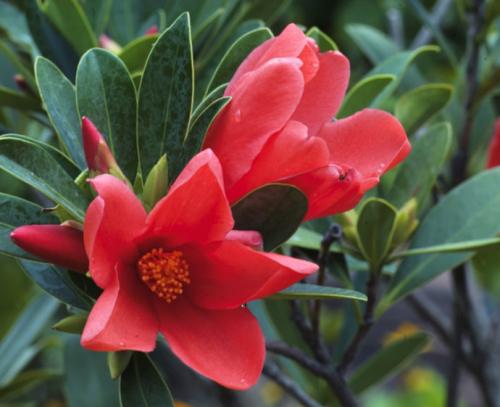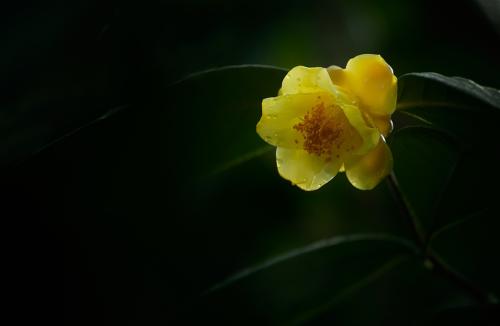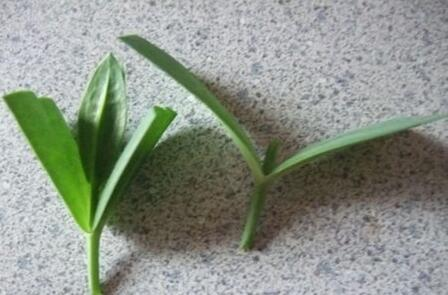Steps of Camellia Cuttage
Step one
Choose sandy soil with loose soil and good drainage, usually a mixture of perlite and coarse sand or vermiculite.
Step two
Choose the well-developed branches, usually the twigs are longer and the thicker branches are shorter, and then cut them along the cutting point.
Step three
Soak the cut branches with potassium permanganate and rooting powder for about 10 minutes, then insert them into the soil and wait for them to take root.

The method of cutting propagation of camellia is simple.
Cutting Propagation methods of Camellia 1. Cutting soil selection
The cutting soil can generally be made from a mixture of many kinds of basin soil, and sand and shavings are chosen here, because the sand is more convenient, construction sites and beaches can be found, and the impurities and soil in the sand should be rinsed away first.
Wash the sand and sift it first, and get rid of the thicker sand and stones.
2. Branch selection
The basic rule of selected camellia cuttings is: slender, thick and short, flower friends try to cut small branches to take longer, cut thicker branches to be shorter, generally cut length is about 10 cm, if cut too short will sprout relatively slowly.
3. Cutting method
When cutting branches, you must first find an iron wire or chopsticks or branches that are similar in thickness to the cutting branches, drill a hole in the soil, and then gently cut down the camellia branches to avoid the friction between the cutting branches and the sand to affect the effect of cutting.
In general, after all the branches of camellia are cut, it is recommended that the sand of the matrix be watered so as to combine them closely with the branches of cuttings. Then put the flowerpot after cutting in a cool place for maintenance.
4. Maintenance and management after cutting.
After camellia cuttings, it usually takes two months to take root quickly (spring), and it may take about three months if it is slow. The roots of the cutting seedlings of camellia are all capillary roots, and the fleshy roots are very tender. It takes about a month to make it lignified to adapt to the growth environment.
During the maintenance period, if the weather is clear and the temperature is high, the matrix will dry relatively quickly, so it is necessary to spray water properly in time.
Cutting time and method of Camellia
Camellia cutting methods 1. Need to know before cutting
A, Camellia cutting time: Camellia can be cut all the year round, but the best time is autumn and spring, winter cutting also needs to keep warm, the difficulty is too high.
B, cutting substrate: it is best to choose loose plain soil (such as pure loess), or coarse vermiculite can be used as cutting substrate. Must not use humus matrix, otherwise it is easy to burn out the new roots.
C, branch selection: annual, semi-lignified branches, this kind of branch vitality is the best, is the most ideal cutting. The best length of branches is about 10 centimeters. Keep two or three leaves, and cut the large leaves in half, which can reduce the evaporation of water.
2. Cutting method
A, mix mud: pure loess or laterite is mixed with water into mud, according to the instructions, mixed with carbendazim and rooting powder. Carbendazim can kill germs on the surface and inside of branches, while rooting powder can effectively increase the probability of rooting.
B, dip in mud: this is our tip. Dip the roots of camellias with mud. This layer of mud can play a good role in sterilization and rooting.
The method is also very simple, about three to five centimeters at the bottom of the branch, dip a layer of mud in the mud. Wait half an hour or so after a little dry, repeat this step, usually two or three times, the root of the branch into the following ball on it.
C, cutting: dig a small hole in the matrix, bury the branches inside, do not insert the cuttings directly into the matrix, so that the mud is easy to fall off, can not play the role of root protection. After watering thoroughly, put it in a place that is ventilated but will not be exposed to direct sunlight. If it is cut in winter, it needs to be kept warm to take root.
3. Management after cuttage
This kind of cuttage can make your later management a little easier, usually watering once a week. The mud wrapped in the root of the branch can speed up the rooting time of camellia by about a month, which usually takes two months to take root. The earlier the roots take root, the more likely the branches are to survive. Therefore, this method can also greatly improve the survival rate of camellia cuttings. After taking root, the camellias grow three to five leaves and then transplant them into a pot for normal maintenance.
Key points of Cuttage Propagation of Camellia
1. Cutting time: take Fujian area as an example, most of them are planted in the nursery on the ground from June 10 to 30, and can also be cut in mud basin or wooden box containers.
2. Cuttings selection: select the current year's twigs, and take the annual semi-mature branches with full external tissue of the crown, complete leaves and full leaf buds as cuttings, with a length of 8cm and 10 cm, leaving 2 leaves at the apex.
3. Cutting: when cutting, the base takes a little old branch as much as possible, and it is easy to form callus and root quickly after cutting. Cut the cuttings early in the morning and insert them whenever you want.
4. Cutting method: insert about 3 cm of seedbed substrate, require leaves to hand over each other when cutting, press solid with fingers after cutting, and dip 0.4% 0.5% indolebutyric acid solution into the base of cuttings for 2-5 seconds, which can obviously promote rooting. It is better to insert it shallowly, so that it can heal and take root quickly.
5. Post-cutting management: the cutting seedbed needs shade, spray the leaves with water every day, keep it moist, keep the temperature at 20: 25 ℃, begin to heal after about three weeks, and take root after six weeks. When the root length is 3 cm to 4 cm, it can be transplanted into the pot. When the base minister has new roots, and the top of the branch has new shoots and new leaves, it can be transplanted.
6. Survival transplantation: cuttings can generally be transplanted from mid-September to early October of that year. If there is no transplantation at this time, it is better to wait for transplantation in March of the vertical year, so that more roots can be grown in the same place, and the survival rate after transplantation is higher. At this time, it coincides with another growth period of camellias, which has many benefits for growth and development. It should be noted that if the cutting medium is river sand or rice chaff ash, it should be transplanted and planted as soon as possible after rooting and growing leaves, because of the lack of nutrition in these media, the growth of survival seedlings in the nursery will be affected for a long time.
- Prev

Propagation mode of camellia
The main results are as follows: 1. During the growing period, the well-developed branches are selected and prepared before cutting, and finally inserted into the soil to wait for their roots. 2. Select a suitable plant as the rootstock by grafting, first plant the rootstock into the soil, then closely fit the camellia and the rootstock, and wrap them with plastic film
- Next

Propagation method of Platycodon grandiflorum-cutting
Platycodon grandiflorum cutting: material selection wants to be very successful, and material selection is also very important. It is best to choose the part with strong meristematic ability in Platycodon grandiflorum, and you can choose the stem under the second pair of leaves under the heart leaves after jointing. Do not choose the stems under the first pair of leaves under the heart leaves, because they are still delicate
Related
- Fuxing push coffee new agricultural production and marketing class: lack of small-scale processing plants
- Jujube rice field leisure farm deep ploughing Yilan for five years to create a space for organic food and play
- Nongyu Farm-A trial of organic papaya for brave women with advanced technology
- Four points for attention in the prevention and control of diseases and insect pests of edible fungi
- How to add nutrient solution to Edible Fungi
- Is there any good way to control edible fungus mites?
- Open Inoculation Technology of Edible Fungi
- Is there any clever way to use fertilizer for edible fungus in winter?
- What agents are used to kill the pathogens of edible fungi in the mushroom shed?
- Rapid drying of Edible Fungi

